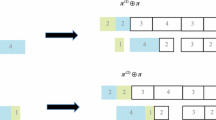Abstract
A new deterministic flow shop problem is studied where the objective is to minimize the total WIP (work-in-process) cost. Based on a value added model, the unit time WIP cost increases as a job passes through various stages in the production process.
The recognition version is unary NP-Complete even for two machines. Several simple and intuitive heuristics are presented. For each heuristic, we determine asymptotically attainable upper bounds on the relative error. Finally, the heuristics are empirically evaluated.
Similar content being viewed by others
References
Adiri, I., & Amit, N. (1984). Openshop and flowshop scheduling to minimize sum of completion times. Computers & Operations Research, 11, 275–284.
Conway, R., Maxwell, W., McClain, J. O., & Thomas, L. J. (1988). The role of work-in-process inventory in serial production lines. Operations Research, 36, 229–241.
Conway, R. W., Maxwell, W. L., & Miller, L. W. (1967). Theory of scheduling. Reading: Addison-Wesley.
Croce, F. D., Ghirardi, M., & Tadei, R. (2002). An improved branch-and-bound algorithm for the two machine total completion time flow shop problem. European Journal of Operational Research, 139, 293–301.
Croce, F. D., Narayan, V., & Tadei, R. (1996). The two-machine total completion time flow shop problem. European Journal of Operational Research, 90, 227–237.
Garey, M. R., Johnson, D. S., & Sethi, R. (1976). The complexity of flowshop and jobshop scheduling. Mathematics of Operations Research, 1, 117–129.
Gonzalez, T., & Sahni, S. (1978). Flowshop and job shop schedules: complexity and approximation. Operations Research, 26, 36–52.
Graham, R. L., Lawler, E. L., Lenstra, J. K., & Rinnooy Kan, A. H. G. (1979). Optimization and approximation in deterministic sequencing and scheduling: a survey. Annals of Discrete Mathematics, 5, 287–326.
Hall, N. G., & Sriskandarahjah, C. (1996). A survey of machine scheduling problems with blocking and no-wait in process. Operations Research, 44, 510–525.
Ho, J. C., & Chang, Y. L. (1991). A new heuristic for the n-job, m-machine flow-shop problem. European Journal of Operational Research, 52, 194–202.
Ho, J. C. (1995). Flowshop sequencing with mean flowtime objective. European Journal of Operational Research, 81, 571–578.
Hoogeveen, J. A., & Kawaguchi, T. (1999). Minimizing total completion time in a two-machine flowshop: analysis of special cases. Mathematics of Operations Research, 24, 887–910.
Hoogeveen, H., Schuurman, P., & Woeginger, G. J. (1998). Non-approximability results for scheduling problems with minsum criteria. In Proceedings of the 6th international IPCO conference on integer programming and combinatorial optimization (pp. 353–366).
Kamoun, H., & Srikandarajah, C. (1993). The complexity of scheduling jobs in repetitive manufacturing systems. European Journal of Operational Research, 70, 350–364.
Kanet, J. J., & Sridaharan, V. (2000). Scheduling with inserted idle time: problem taxonomy and literature review. Operations Research, 48, 99–110.
Matsuo, H. (1990). Cyclic sequencing problems in the two-machine permutation flow shop: complexity, worst-case, and average-case analysis. Naval Research Logistics, 37, 674–694.
Lee, W.-C., & Wu, C.-C. (2001). Minimizing the total flow time and tardiness in a two-machine flow shop. International Journal of Systems Science, 32, 365–373.
Röck, H. (1984). Some new results in no-wait flowshop scheduling. Zeitschrift Für Operations Research, 28, 1–16.
Schuurman, P., & Woeginger, G. J. (1999). Polynomial time approximation algorithms for machine scheduling: ten open problems. Journal of Scheduling, 2, 203–213.
Sipper, D., & Shapira, R. (1989). JIT vs. WIP—a trade-off analysis. International Journal of Production Research, 27, 903–914.
van de Velde, S. L. (1992). Minimizing the sum of the job completion times in the two-machine flow shop by Lagrangian relaxation. Annals of Operations Research, 26, 257–268.
Vempati, V. S., Chen, C.-L., & Bullington, S. F. (1993). An effective heuristic for flow shop problems with total flow time as criterion. Computers and Industrial Engineering, 25, 219–222.
Vollman, T. E., Berry, W. L., & Whybark, D. C. (1997). Manufacturing planning and control systems. New York: McGraw-Hill.
Wang, C., Chu, C., & Proth, J.-M. (1996). Efficient heuristic and optimal approaches for n/2/F/∑C i scheduling problems. International Journal of Production Economics, 44, 225–237.
Author information
Authors and Affiliations
Corresponding author
Additional information
An erratum to this article is available at http://dx.doi.org/10.1007/s10951-015-0420-6.
Rights and permissions
About this article
Cite this article
Yang, J., Posner, M.E. Flow shops with WIP and value added costs. J Sched 13, 3–16 (2010). https://doi.org/10.1007/s10951-009-0130-z
Published:
Issue Date:
DOI: https://doi.org/10.1007/s10951-009-0130-z




